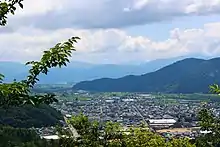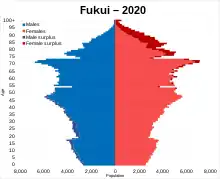Fukui Prefecture
福井県 | |
|---|---|
| Japanese transcription(s) | |
| • Japanese | 福井県 |
| • Rōmaji | Fukui-ken |
 Panoramic view of the Fukui plain, Fukui prefecture from the top of Monju | |
 Flag  Symbol | |
| Anthem: Fukui kenminka | |
 | |
| Country | |
| Region | Chūbu (Hokuriku) |
| Island | Honshū |
| Capital | Fukui |
| Subdivisions | Districts: 7, Municipalities: 17 |
| Government | |
| • Governor | Tatsuji Sugimoto |
| Area | |
| • Total | 4,190.49 km2 (1,617.96 sq mi) |
| • Rank | 34th |
| Population (June 1, 2017) | |
| • Total | 778,943 |
| • Rank | 43rd |
| • Density | 185.95/km2 (481.6/sq mi) |
| GDP | |
| • Total | JP¥ 3,695 billion US$ 33.9 billion (2019) |
| ISO 3166 code | JP-18 |
| Website | www.pref.fukui.jp/english/ |
| Symbols of Japan | |
| Bird | Dusky thrush (Turdus naumanni) |
| Flower | Narcissus (Narcissus tazetta) |
| Tree | Pine tree (Pinus) |
Fukui Prefecture (福井県, Fukui-ken) is a prefecture of Japan located in the Chūbu region of Honshū.[2] Fukui Prefecture has a population of 778,943 (1 June 2017) and has a geographic area of 4,190 km2 (1,617 sq mi). Fukui Prefecture borders Ishikawa Prefecture to the north, Gifu Prefecture to the east, Shiga Prefecture to the south, and Kyoto Prefecture to the southwest.
Fukui is the capital and largest city of Fukui Prefecture, with other major cities including Sakai, Echizen, and Sabae.[3] Fukui Prefecture is located on the Sea of Japan coast and is part of the historic Hokuriku region of Japan. The Matsudaira clan, a powerful samurai clan during the Edo period that became a component of the Japanese nobility after the Meiji Restoration, was headquartered at Fukui Castle on the site of the modern prefectural offices. Fukui Prefecture is home to the Kitadani Formation, the Ichijōdani Asakura Family Historic Ruins, and the Tōjinbō cliff range.
Prehistory
The Kitadani Dinosaur Quarry, on the Sugiyama River within the city limits of Katsuyama, has yielded animals such As Fukuiraptor, Fukuisaurus, Nipponosaurus, Koshisaurus, Fukuivenator, Fukuititan and Tambatitanis as well as an unnamed dromaeosaurid.
History
Fukui originally consisted of the old provinces of Wakasa and Echizen, before the prefecture was formed in 1871.[4]
During the Edo period, the daimyō of the region was surnamed Matsudaira, and was a descendant of Tokugawa Ieyasu.
During World War II, Fukui was heavily bombed and its palace, Fukui Castle, surrounded by a moat, was demolished. Buildings for the Fukui Prefectural government were built on the site of the castle.
Geography
Fukui faces the Sea of Japan, and has a western part (formerly Wakasa) which is a narrow plain between the mountains and the sea, and a larger eastern part (formerly Echizen) with wider plains including the capital and most of the population. The province lies within Japan's "Snow country".

City Town



As of 31 March 2008, 15% of the total land area of the prefecture was designated as Natural Parks, namely the Hakusan National Park; Echizen-Kaga Kaigan and Wakasa Wan Quasi-National Parks; and Okuetsu Kōgen Prefectural Natural Park.[5]
Cities
Nine cities are located in Fukui Prefecture:
| Name | Area (km2) | Population | Map | |
|---|---|---|---|---|
| Rōmaji | Kanji | |||
| あわら市 | 116.98 | 28,405 | ||
| 越前市 | 230.7 | 83,078 | ||
| 福井市 | 536.41 | 264,217 | ||
| 勝山市 | 253.88 | 23,527 | ||
| 小浜市 | 233.09 | 29,435 | ||
| 大野市 | 872.43 | 33,640 | ||
| 鯖江市 | 84.59 | 69,338 | ||
| 坂井市 | 209.67 | 92,210 | ||
| 敦賀市 | 251.39 | 66,123 | ||
Towns
These are the towns in each district:
| Name | Area (km2) | Population | District | Map | |
|---|---|---|---|---|---|
| Rōmaji | Kanji | ||||
| 越前町 | 153.15 | 20,709 | Nyū District | ||
| 永平寺町 | 94.43 | 18,746 | Yoshida District | ||
| 池田町 | 194.65 | 2,628 | Imadate District | ||
| 美浜町 | 152.35 | 9,643 | Mikata District | ||
| 南越前町 | 343.69 | 10,745 | Nanjō District | ||
| おおい町 | 212.19 | 8,102 | Ōi District | ||
| 高浜町 | 72.4 | 10,490 | Ōi District | ||
| 若狭町 | 178.49 | 14,577 | Mikatakaminaka District | ||
Mergers
Economy
- Sabae is known for producing 90% of Japan's domestically-made glasses.
- There are several nuclear power plants located along Wakasa Bay in Tsuruga which supply power to the Keihanshin metropolitan region. It has 14 reactors, the most of any prefecture.[6]
Demographics

Fukui is one of the less populated prefectures of Japan; in September 2015 there were an estimated 785,508 people living in 281,394 households.[7] As seen in most of Japan, Fukui is facing the problem of both an aging and decreasing population; 28.6% of the population was over the age of 65 in July 2015[7] and the population has decreased by 2.6% from the 806,000 measured in the October 2010 national census.[8]
Culture
- Ichijōdani Asakura Family Historic Ruins is one of the most important cultural heritage sites in Japan.
- Eihei-ji is a temple offering training and education to Buddhist monks. Founded by Dogen Zenji in 1244, Eiheiji is located on a plot of land covering about 33 hectares.
- Myōtsū-ji's Three-storied Pagoda and Main Hall are National Treasures of Japan.
- Fukui is home to Maruoka Castle, the oldest standing castle in Japan. It was built in 1576.
- Many dinosaur fossils have been excavated in Fukui and they can be seen at the Fukui Prefectural Dinosaur Museum.
- Residents of Fukui Prefecture have a distinctive accent, Fukui-ben.
- Fukui has long been a center for papermaking in Japan (along with Kyoto). Its Echizen Papermaking Cooperative is a world-famous collection of papermakers making paper in the traditional Echizen style.
- Fukui is also renowned for its clean water and crops, which result in delicious sake, rice, and soba noodles.
- In August 2010 Fukui launched its own dating website entitled Fukui Marriage-Hunting Café in hopes of helping the declining population growth of Japan increase. Couples who meet in the site and continue on to marry receive monetary aid from the government as well as gifts.[9]
Friendship cities
 Vihti, Finland
Vihti, Finland Winsen (Luhe), Germany
Winsen (Luhe), Germany
Education
University
Transportation

Railroad
- JR West
- Hokuriku Line
- Obama Line
- Kuzuryu Line
- Echizen Railway
- Katsuyama-Eiheiji Line
- Mikuni-Awara Line
- Fukui Railway
- Fukubu Line
- Hokuriku Shinkansen (from March, 2024)
Road
Expressway and Toll Road
- Hokuriku Expressway
- Maizuru-Wakasa Expressway
- Chubu Jukan Expressway
- Mikata Lake Rainbow Road
- Mount Hoonji Toll Road
National Highway
- Route 8
- Route 27
- Route 157
- Route 158
- Route 161
- Route 162
- Route 303
- Route 305
- Route 364
- Route 365
- Route 367
- Route 416
- Route 417
- Route 418
- Route 476
Port
- Tsuruga Port - Ferry route to Niigata, Akita, Tomakomai, Otaru and International container hub
- Fukui Port

Tourism


- Ichijōdani Asakura Family Historic Ruins
- Eihei-ji Temple
- Tōjinbō, a scenic piece of coastline, which is also a notorious spot for suicide.
- Echizen crabs are a local delicacy available year-round, though the crabbing season is during the winter.
- Another traditional sea-side Fukui dish is genge, a small guppy-like fish that when eaten raw as sashimi, gives the body a brief tingling sensation.
- Awara is a famous onsen in the north of the prefecture.
- Takefu Chrysanthemum Character Doll Exhibition, held in Takefu Central Park on every October to November, first held on 1952.
- Mikuni Festival, a combine portable shrine and floats traditional festival, every later May on every year, first held in 1697.
Notes
- ↑ "2020年度国民経済計算(2015年基準・2008SNA) : 経済社会総合研究所 - 内閣府". 内閣府ホームページ (in Japanese). Retrieved 2023-05-18.
- ↑ Nussbaum, Louis-Frédéric. (2005). "Fukui-ken" in Japan Encyclopedia, p. 217, p. 217, at Google Books; "Chūbu" Japan Encyclopedia, p. 126, p. 126, at Google Books.
- ↑ Nussbaum, "Fukui" in Japan Encyclopedia, p. 217, p. 217, at Google Books.
- ↑ Nussbaum, "Provinces and prefectures" in Japan Encyclopedia, p. 780, p. 780, at Google Books.
- ↑ "General overview of area figures for Natural Parks by prefecture" (PDF). Ministry of the Environment. Retrieved 4 February 2012.
- ↑ Fujioka, Chisa. "Japan anti-nuclear movement gains traction as crisis drags on". Reuters. 2011-04-08. Retrieved 2014-02-07.
- 1 2 "福井県の推計人口" [Fukui Prefecture Population Estimate] (in Japanese). Fukui Prefectural Government. 1 October 2015. Retrieved 27 October 2015.
- ↑ "第2章 人口の地域分布" [Regional distribution of population] (PDF) (in Japanese). Retrieved 27 October 2015.
- ↑ Ansari, Aziz; Klinenberg, Eric (2015). Modern Romance. p. 155. ISBN 978-1594206276.
References
- Nussbaum, Louis-Frédéric and Käthe Roth. (2005). Japan encyclopedia. Cambridge: Harvard University Press. ISBN 978-0-674-01753-5; OCLC 58053128




